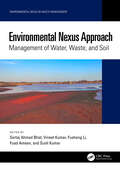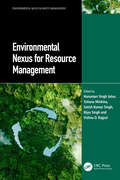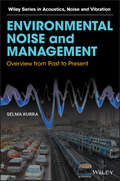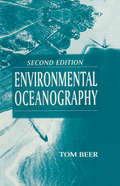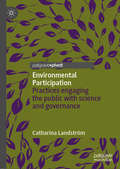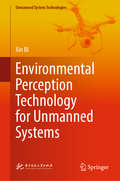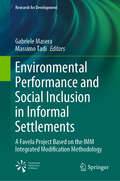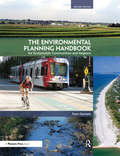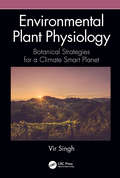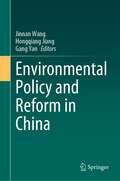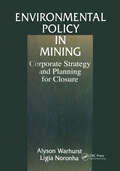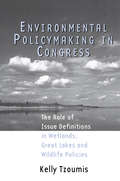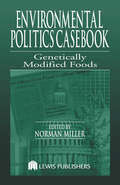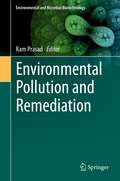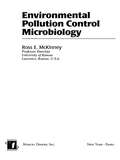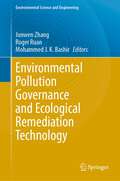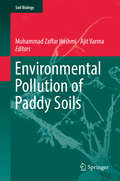- Table View
- List View
Environmental Nexus Approach: Management of Water, Waste, and Soil (Environmental Nexus in Waste Management)
by Vineet Kumar Sartaj Ahmad Bhat Fusheng Li Fuad AmeenEnvironmental Nexus Approach: Management of Water, Waste, and Soil establishes linkages between environmental resources, such as water, waste, and soil, in order to facilitate sustainable management of these resources. It shows the nexus approach as a policy-relevant means of environmental management by focusing on integrated management of water, waste, and soil resources. It synthesizes interdisciplinary theory, concepts, definitions, models, and findings involved in complex global sustainability problem-solving, making it an essential guide and reference. It includes real-world examples and applications making the book accessible to a broader interdisciplinary readership. Features: Explores cutting-edge developments in the environmental nexus approach of water, waste, and soil. Introduces the key mechanisms regarding antibiotic resistance genes, microplastics, and other emerging contaminants in the water, waste, and soil nexus. Investigates the fate and behavior of heavy metals, polyaromatic hydrocarbons, plastics, and pesticides in soil systems and their risk assessment. Provides insights into the latest developments, current research perspectives, technology development, critical thinking, and societal requirements of the environmental nexus between water, waste, and soil. This book is aimed at graduate students and researchers in environmental science and engineering, environmental engineering, and waste management.
Environmental Nexus for Resource Management (Environmental Nexus in Waste Management)
by Satish Kumar Singh Vishnu D. Rajput Hanuman Singh Jatav Tatiana Minkina Bijay SinghThis book gives detailed information about how soil, water and wastes can be managed to overcome the various global issues via possible nexus thinking. The emphasis is on the environmental resource perspective of global climate change-related issues. It provides stepwise information on climate change and adaption strategies, urbanization and its impact and management strategies, environmental nexus approaches to cope with global challenges and recourses conservation and ecological approaches to restore the damaged ecosystem.Features: Compiles the possible nexus approaches that contribute to managing the atmospheric environmental variables in sustainable ways Focuses on environmental resources perspective of the global change Covers how soil, water and waste may be managed in a nexus Explains modern strategies to manage the present environmental situation that are feasible and safe to the environment Discusses environmental nexus for judicious resource management This book is aimed at researchers and graduate students in environmental sciences and engineering and sustainable development.
Environmental Noise and Management: Overview from Past to Present (Wiley Series in Acoustics Noise and Vibration)
by Selma KurraEnvironmental Noise and Management Selma Kurra, Istanbul Technical University and dBKES Engineering Ltd, Turkey A comprehensive overview of environmental noise pollution from the standpoint of environmental impact and control Environmental noise is studied, regulated and monitored by many governments and institutions, as well as forming the basis for a number of different occupations due to the adverse effects of noise exposure. Environmental Noise and Management provides a comprehensive overview of environmental noise pollution. The book begins by covering the fundamentals of noise and acoustics, major noise sources and prediction and evaluation techniques. Developments in noise measuring techniques, and mapping and improvement of legislation to control noise pollution are then discussed, and international regulations are presented. Technological advances and recent developments regarding strategy and action plans are also covered in depth. Key features: Summarizes the relevant international standards covering noise pollution and environmental engineering practice. Presents technological advances and recent developments regarding strategy and action plans. Covers developments in noise measuring techniques, prediction models, mapping and improvement of legislation to control noise pollution. Environmental Noise and Management is a comprehensive resource for researchers and graduate students who are involved in noise pollution from the standpoint of environmental impact and control.
Environmental Noise Barriers: A Guide To Their Acoustic and Visual Design, Second Edition
by Benz Kotzen Colin EnglishEnvironmental Noise Barriers is a unique one-stop reference for practitioners, whether acoustical engineers, landscape architects, or manufacturers, and for highways departments in local and central authorities. This extensively revised new edition is updated in line with UK and EU legislation and international provision of barriers.
Environmental Noise Control: The Indian Perspective in an International Context
by Naveen GargThis book provides a concise and up-to-date overview of environmental noise control issues, utilizing specific case studies from India to help explore noise mapping and monitoring, impact analysis, and policy, among other relevant topics. The book provides an extensive review of recent studies, including references, and describes the latest noise monitoring structures. It also addresses heretofore under-emphasized topics, including but not limited to acoustic metrology, Multi Attribute Decision Making (MADM) techniques, and sound insulation utilizing passive control strategies.
Environmental Oceanography: An Introduction To The Behaviour Of Coastal Waters (CRC Marine Science #11)
by Tom BeerThe second edition of Environmental Oceanography is the first textbook to link the needs of the coastal oceanographer and the environmental practitioner. The ever-increasing human impact on the environment, and particularly on the coastal zone, has led governments to carefully examine the environmental implications of development proposals. This book provides the background needed to undertake coastal oceanographic investigations and sets them in context by incorporating case studies and sample problems based on the author's experience as an environmental consultant.
Environmental Participation: Practices engaging the public with science and governance
by Catharina LandströmThis book introduces environmental participation as a distinct field comprising diverse practices. It presents examples of public participation specifically in environmental science, decision making and expertise. The first chapter introduces the science studies perspective and the key concepts that underpin the argument for approaching such a range of practices as a coherent field. The following three chapters explore a wide range of practical examples of how the public can participate in all three domains. Drawing on her experience with a variety of transdisciplinary projects Landström discusses topics including the coproduction of knowledge about flooding, community involvement with radioactive waste disposal and collaborative water quality modelling. She then goes on to cover citizen science and social movement expertise as environmental participation practices. The concluding chapter reflects on the challenges as well as future opportunities of environmental participation. This book is aimed at readers from a variety of academic and non-academic backgrounds and will be a great interest to social and natural scientists, students and practitioners.
Environmental Perception Technology for Unmanned Systems (Unmanned System Technologies)
by Xin BiThis book focuses on the principles and technology of environmental perception in unmanned systems. With the rapid development of a new generation of information technologies such as automatic control and information perception, a new generation of robots and unmanned systems will also take on new importance. This book first reviews the development of autonomous systems and subsequently introduces readers to the technical characteristics and main technologies of the sensor. Lastly, it addresses aspects including autonomous path planning, intelligent perception and autonomous control technology under uncertain conditions. For the first time, the book systematically introduces the core technology of autonomous system information perception.
Environmental Performance and Social Inclusion in Informal Settlements: A Favela Project Based on the IMM Integrated Modification Methodology (Research for Development)
by Gabriele Masera Massimo TadiThis book discusses the potential of a systemic and multidisciplinary design approach to improve urban quality, health, livability, and inclusiveness for people living in informal settlements. In most instances, attempts to address informal settlements lack an adequate assessment of their impact on the wider built environment and implementation of the UN’s Sustainable Development Goals. The Integrated Modification Methodology (IMM), introduced here, offers a systematic, multidisciplinary design tool encompassing several of the aspects that define the environmental performance of urban systems. The book also demonstrates the application of the methodology to an informal settlement, proving its potential to guide systemicurban transformations, also in urban areas lacking formal planning. The case study investigated is in the Rocinha favela in Rio de Janeiro, which ischaracterized by poor water quality, lack of drainage and sanitation systems, and very few green spaces. Based on a rigorous methodology, the process described here can also be applied in similar contexts around the world.
Environmental Planning Handbook
by Tom DanielsEnvironmental protection is a global issue. But most of the action is happening at the local level. How can communities keep their air clean, their water pure, and their people and property safe from climate and environmental hazards? Newly updated, The Environmental Planning Handbook gives local governments, nonprofits, and citizens the guidance they need to create an action plan they can implement now. It’s essential reading for a post-Katrina, post-Sandy world.
Environmental Plant Physiology: Botanical Strategies for a Climate Smart Planet
by Vir SinghEnvironmental Plant Physiology provides a stupendous knowledge source for undergraduate and graduate students and their teachers in many inter-related disciplines, like life sciences, agricultural sciences, environmental sciences, ecology, and climatology. Further, this book can also be of vital importance for policy makers and organizations dealing with climate related issues and committed to the cause of the Earth. This book can be instrumental in formulating strategies that can lead us to a climate smart planet. Features: Ecological basis of environmental plant physiology. Energy, nutrient, water, temperature, allelochemical and altitude relations of plants. Stress physiology of plants. Climate change effects on plant physiology. Plants’ adaptations to the changing climate. Evolving botanical strategies for a climate smart planet.
Environmental Policy and NEPA: Past, Present, and Future
by Ray Clark Larry CanterEnvironmental Policy and NEPA is a concise study of environmental policy-where we have come from, what we are facing and where we can go in the future. An outgrowth of initiatives taken by the Council of Environmental Quality (CEQ), and edited by the current Associate Director, this publication studies the effectiveness and efficiency of the implementation of the National Environmental Policy Act (NEPA).Divided into three main sections, part one covers the historical background and trends of NEPA. Part two addresses current substantive and conceptual issues associated with the environmental impact assessment (EIA) process. Part three discusses future opportunities including impact on humans, effective public participation in the EIA process and the need for sustainability.This excellent reference brings together 28 contributing authors who combine their expertise to address a multitude of topics. Environmental Policy and NEPA is mandatory reading for the professional, researcher, government policymaker, activist, student or anyone looking for a complete presentation of the EIA process.
Environmental Policy and Public Health: Principal Health Hazards and Mitigation, Volume 1
by Barry L. Johnson Maureen Y. LichtveldWritten by environmental health experts with long teaching and professional careers in policy and public health, the third edition of Environmental Policy and Public Health comprises two volumes addressing key physical hazards in the environment that impact public health. The first volume on Principal Health Hazards and Mitigation is complemented by the second volume, Emerging Health Hazards and Mitigation. The health of the environment is inextricably linked to that of people. Thoroughly updated, Volume 1 describes how the quality of air, water, and food is threatened by the presence of toxic substances and explains why climate change is a global health priority already impacting human health and the environment. The mitigations discussed in this volume are twofold: policies that are intended for control of specific hazards and suggested hazard interventions. The role of policy in addressing each of these key environmental health areas is extensively discussed in this volume as well. Each chapter explains step by step how new environmental health issues are translated into public health policies and concludes with practice questions to facilitate interactive learning for upper-level undergraduate and graduate students taking courses in public health and environmental sciences. The step-by step approach, as well as the case studies and practice questions, allow for a diverse portfolio of in-person and hybrid pedagogical strategies and tools at the fingertips of faculty who not only teach policy courses, but whose course topics, such as climate and health, have policy relevance.
Environmental Policy and Reform in China
by Jinnan Wang Hongqiang Jiang Gang YanThe book is the collection of the latest research results from Chinese Academy of Environmental Planning in environmental policy and reform during the past years, mainly related to ecological compensation, the emission trading, the environment audit, carbon tax, environment friendly city, environmental health, economic policy in medical waste, scattered coal treatment subsidies, environmental policy efficiency analysis, environmental industry statistics, environmental performance evaluation, green fiscal and taxation policy, etc., presenting the latest achievements, developments and research trends in this field.
Environmental Policy in Mining: Corporate Strategy and Planning
by Alyson Warhurst Ligia NoronhaEcological Management of Mining: Achieving Environmental Compliance is a study and comparison - global in scope - of current practices used by mining firms striving for ecological management. The author takes an integrated and interdisciplinary approach in addressing, analyzing and working towards solutions regarding the complex challenges posed by managing the environmental impacts of mining. The issues addressed range from the ecotoxicological effects of metal residues to the land use effects of mining and from socioeconomic impacts to environmental regulation. The goal of this book is to assist mining companies throughout the world to achieve environmental compliance and improve competitiveness in the context of growing environmental regulation and technological innovation. It is an essential book for the wide variety of professionals working on issues in mining. Like the book and the research itself, the audience is integrated and interdisciplinary including engineers, planners, ecologists, policy makers and economists.
Environmental Policymaking in Congress: Issue Definitions in Wetlands, Great Lakes and Wildlife Policies (Politics and Policy in American Institutions)
by Kelly TzoumisUtilizing current natural resource policies, this work effectively shows how the wetlands fit a dominance model, the Great Lakes is a bounded model, and wildlife is labeled as a valence model. A must read for all interested in congressional policymaking, this book breaks new ground in our understanding of legislative policymaking.
Environmental Politics Casebook: Genetically Modified Foods
by Norman MillerEnvironmental Politics Casebook: Genetically Modified Foods includes testimony, journal and newspaper articles, book chapters, and interest group communications such as press releases and on-line briefs, as well as other studies and reports that constitute the principal elements of the public debate on the genetic modification of food. A companion
Environmental Pollution and Medicinal Plants (Exploring Medicinal Plants)
by Azamal HusenEnvironmental Pollution and Medicinal Plants presents information on the impact of environmental pollution on the performance of medicinal plants at various levels including damage detection, adaptation, tolerance, and physiological and molecular responses.This title draws attention not only to seeking new bioactive compounds for herbal drug preparation, but also on ensuring high standards of quality through evaluation of the chemical purity of medicinal plants growing under polluted conditions. It discusses the latest trends and responses of medicinal plants, indicating their tolerance and adaptation to environmental pollution. This book also focuses on secondary metabolites, phytochemicals, and bioactive compounds associated with medicinal plants growing in contaminated conditions.This book will be indispensable for students and professionals working in the field of environmental pollution, medicinal plants, and herbal medicine, as well as for plant biologists, economic botanists, molecular biologists, and biotechnologists.. KEY FEATURES Explains the global trend of environmental pollution and its impact on medicinal herbs with the help of clear text and attractive illustrations. Provides a comprehensive overview of medicinal plants and their interaction with environmental pollution in terms of damage detection, repair, acclimation, tolerance, adaptation, and physiological responses. Discusses the production of secondary metabolites, phytochemicals, and bioactive compounds (used for herbal drug preparation) in medicinal plants growing in the vicinity of contamination and pollution load. Highlights opportunities and future challenges in "omics" studies on medicinal plants.
Environmental Pollution and Natural Resource Management (Springer Proceedings in Earth and Environmental Sciences)
by Kanchan Deoli Bahukhandi Nitin Kamboj Vishal KambojThis book presents conference articles related to environmental pollution and natural resource management, and environmentally friendly technologies that lead to sustainable development presented in the Conference "Sustainable Management of Environment & Natural Resource Through Innovation in Science and Technology". The book highlights the latest development and innovation in environmental science, technology, and interdisciplinary research to improve the environment and health safety. It includes innovations and improvisations in the broad area of science and technology, natural resource, and environment management. It deliberates on the current burning issues of environment protection management and sustainable development, environmental pollution, global warming, and climate change.The development strategies must therefore be shaped by the following components:The satisfaction of basic human requirementsThe eradication of povertySelf-reliant and participatory developmentEnvironmental consciousnessTechnology has to play a critical role in the process of changing industrial society. But innovation has to be embedded in social and organizational innovation. This book provides a wide range of research articles in the area of science and technology, sustainability, natural resource management, ecology and its environmental fields, geosciences and geology, atmospheric sciences, sustainability, climate change, and extreme weather, global warming, and environmental change, the effect of climate change on the ecosystem, environment, and pollution.
Environmental Pollution and Remediation (Environmental and Microbial Biotechnology)
by Ram PrasadThis book presents state-of-the-art environmental remediation processes. Environmental protection and management is a global concern, especially in the context of industrial regions. Over the years, several conventional, engineering-based physicochemical decontamination methods have used in the remediation of polluted sites. However, these methods are expensive and have limited efficiency. Drawing on research and examples from around the world, this book offers a comprehensive review of and insights into green technologies and sustainable remediation alternatives. It discusses the emerging importance of nanotechnology, chemo and biosensors, indicator species, microbe-based remediation of organic compounds, and ex-situ remediation methods. Addressing the growing global need for a holistic overview of the environmental remediation of polluted sites, it will appeal to teachers, researchers, scientists, capacity builders, and policymakers. It also serves as additional reading material for undergraduate and graduate students of biotechnology and environmental sciences.
Environmental Pollution Control Microbiology: A Fifty-Year Perspective (Civil And Environmental Engineering Ser. #Vol. 16)
by Ross E. McKinneyCompiling knowledge gained through more than 50 years of experience in environmental engineering technology, this book illustrates the application of fundamental concepts in microbiology to provide a sound basis for the design and operation of various biological systems used in solving environmental challenges in the air, water, and soil. Environme
Environmental Pollution Governance and Ecological Remediation Technology (Environmental Science and Engineering)
by Junwen Zhang Roger Ruan Mohammed J. K. BashirThis book provides the advance research results of environmental pollution and governance and covers the main research field of environmental remediation, environmental monitoring, sanitation and so on. Nowadays, environmental pollution, as one of the most important problems in the world, has seriously affected the global ecology, temperature, water resources and so on. Therefore, the research on environmental governance can better help us comprehend the methods and measures of environmental protection and protect our ecology more scientifically and effectively. This book also aims to promote scientific information interchange between scholars from the top universities, research centers and high-tech enterprises working all around the world. It is beneficial to scholars, engineers and researchers in the field of environmental engineering and environmental governance.
Environmental Pollution of Paddy Soils (Soil Biology #53)
by Muhammad Zaffar Hashmi Ajit VarmaThe paddy field is a unique agro-ecosystem and provides services such as food, nutrient recycling and diverse habitats. However, chemical contamination of paddy soils has degraded the quality of this important ecosystem. This book provides an overview of our current understanding of paddy soil pollution, addressing topics such as the major types of pollutants in contaminated paddy soil ecosystems; factors affecting the fate of pollutants in paddy soil; biomonitoring approaches to assess the contaminated paddy soil; the impact of chemicals on soil microbial diversity; and climate change. It also covers arsenic and heavy metal pollution of paddy soils and their impact on rice quality. Further, new emerging contaminants such as antibiotics and antibiotics resistance genes (ARGs) in paddy soil and their impact on environmental health are also discussed. The last chapters focus on the bioremediation approaches for the management of paddy soils.
Environmental Preservation and the Grey Cliffs Conflict: Negotiating Common Narratives, Values, and Ethos
by Kristin D. PickeringBased on a qualitative, ethnographic, observational case study approach, Environmental Preservation and the Grey Cliffs Conflictpresents an analysis of the conflict negotiation between the U.S. Army Corps of Engineers and a local community that struggled to address a deteriorating Corps-managed recreational lake area in Tennessee known as “Grey Cliffs.” Viewing the dispute from the perspective of a new member of the community and a specialist in technical communication and professional writing, Kristin Pickering provides a unique perspective on this communication process. Though environmental degradation and unauthorized use threatened the Grey Cliffs recreational lake area to the point that the Corps considered closure, community members valued it highly and wanted to keep it open. The community near this damaged and crime-ridden area needed help rejuvenating its landscape and image, but the Corps and community were sharply divided on how to maintain this beloved geographic space because of the stakeholders’ different cultural backgrounds and values, as well as the narratives used to discuss them. By co-constructing and aligning narratives, values, and ethos over time—a difficult and lengthy process—the Corps and community succeeded, and Grey Cliffs remains open to all. Focusing on field notes, participant interviews, and analysis of various texts created throughout the conflict, Pickering applies rhetorical analysis and a grounded theory approach to regulation, identity, sustainability, and community values to analyze this communication process. Illustrating the positive change that can occur when governmental organizations and rural communities work together to construct shared values and engage in a rhetoric of relationship that preserves the environment, Environmental Preservation and the Grey Cliffs Conflict provides key recommendations for resolving environmental conflicts within local communities, especially for those working in technical and professional communication, organizational communication, environmental science, and public policy.
Environmental Problems in Third World Cities
by Jorge E. Hardoy Diana Mitlin David SatterthwaiteDescribes and analyses the environmental problems of Third World cities, showing how they affect human health and the local ecology. The authors show how readily available practical solutions are, if the political means can be found.
